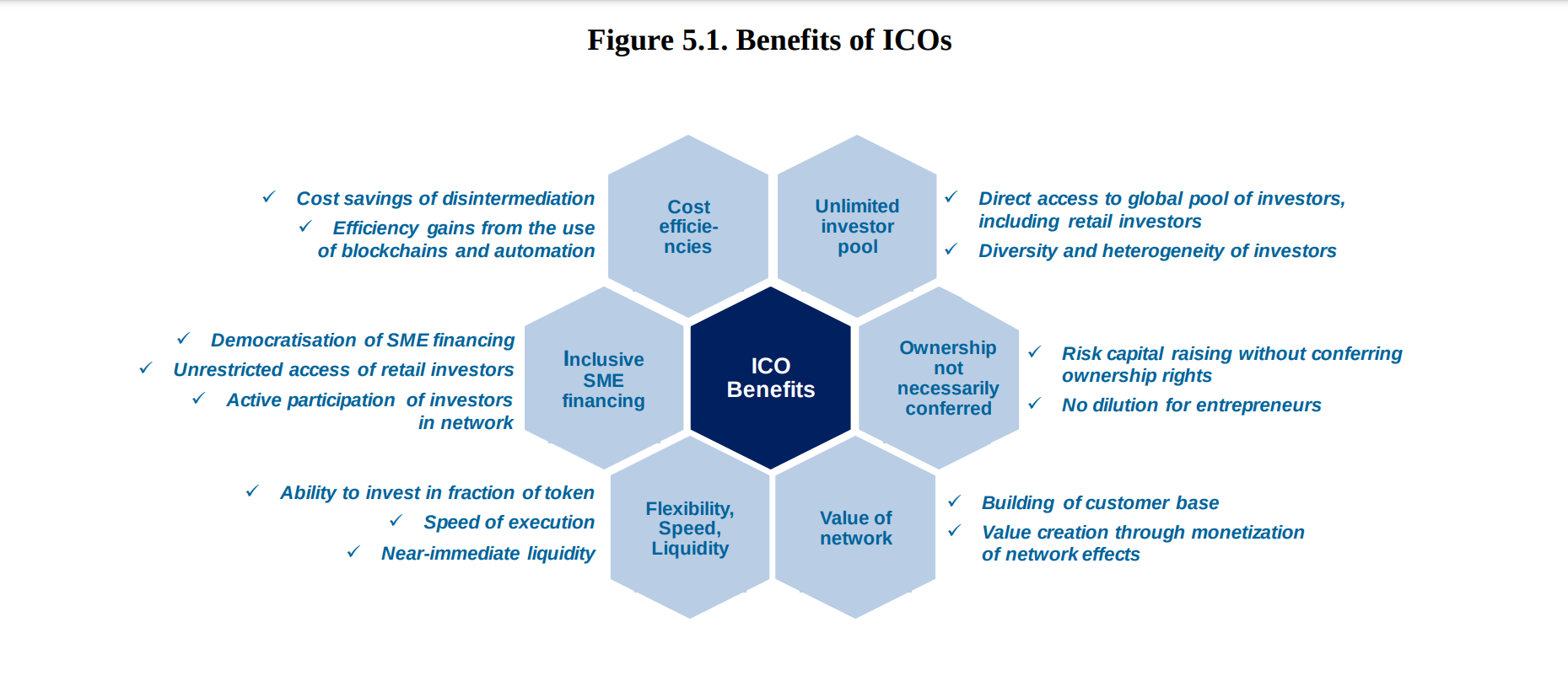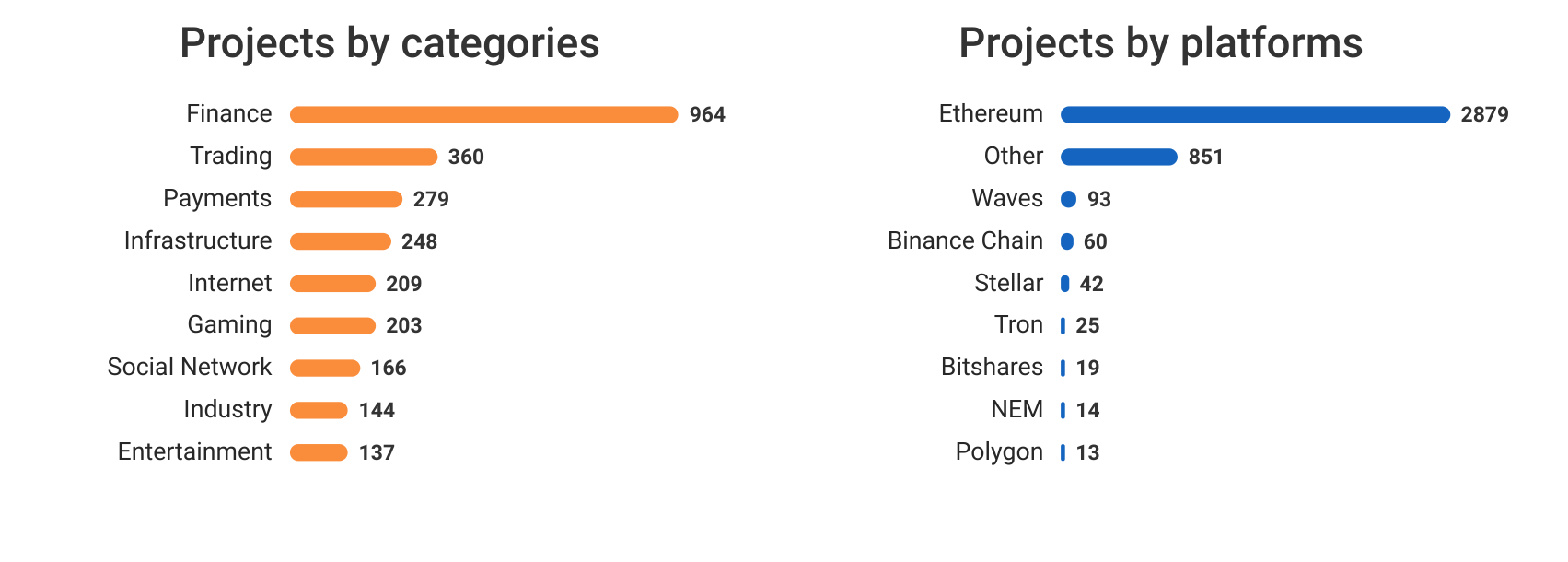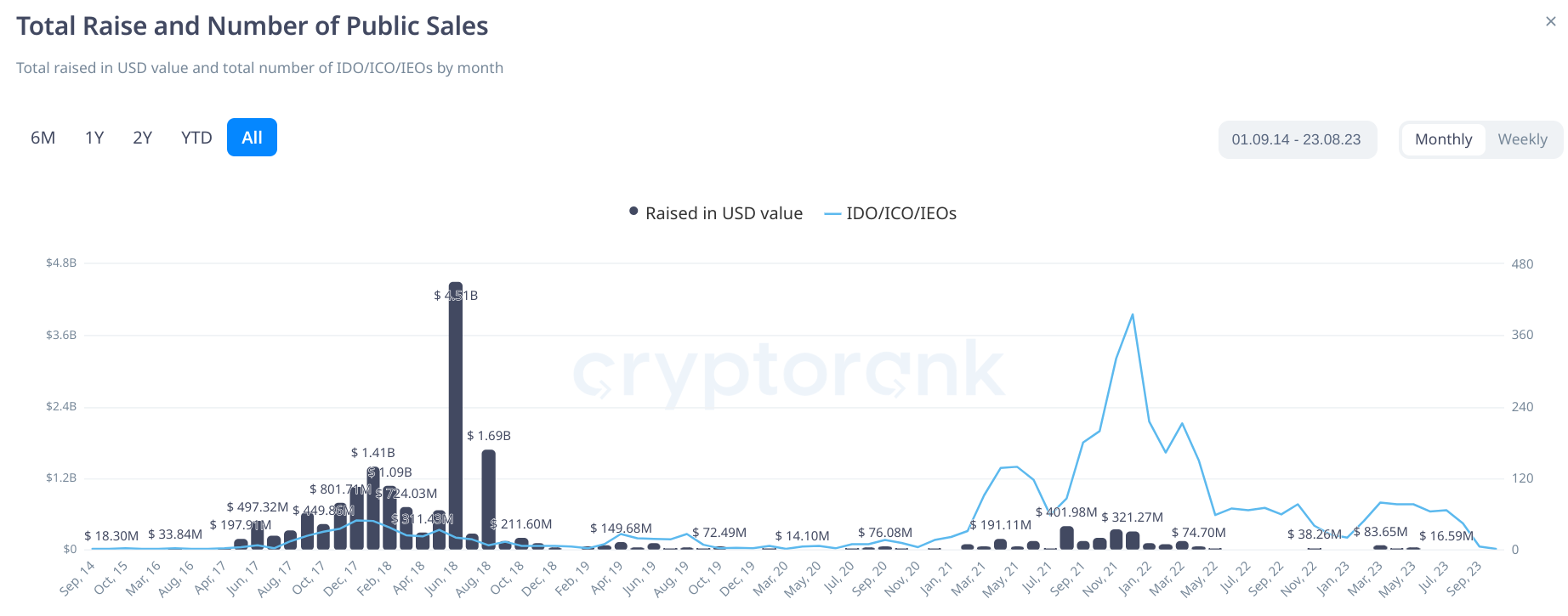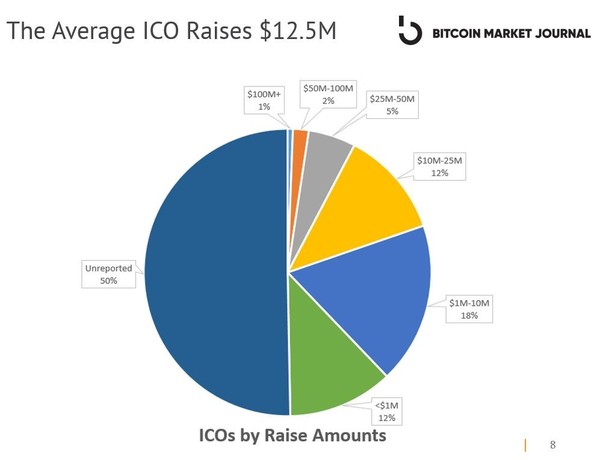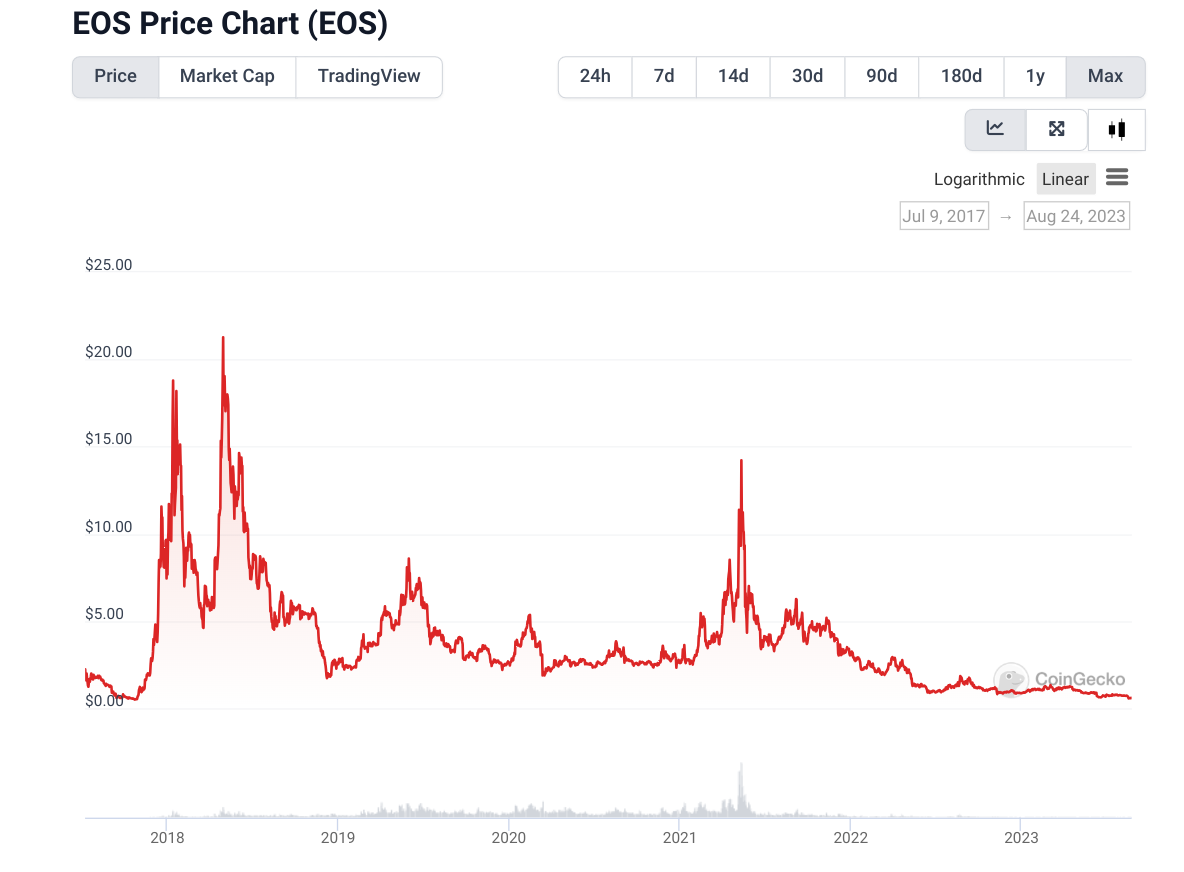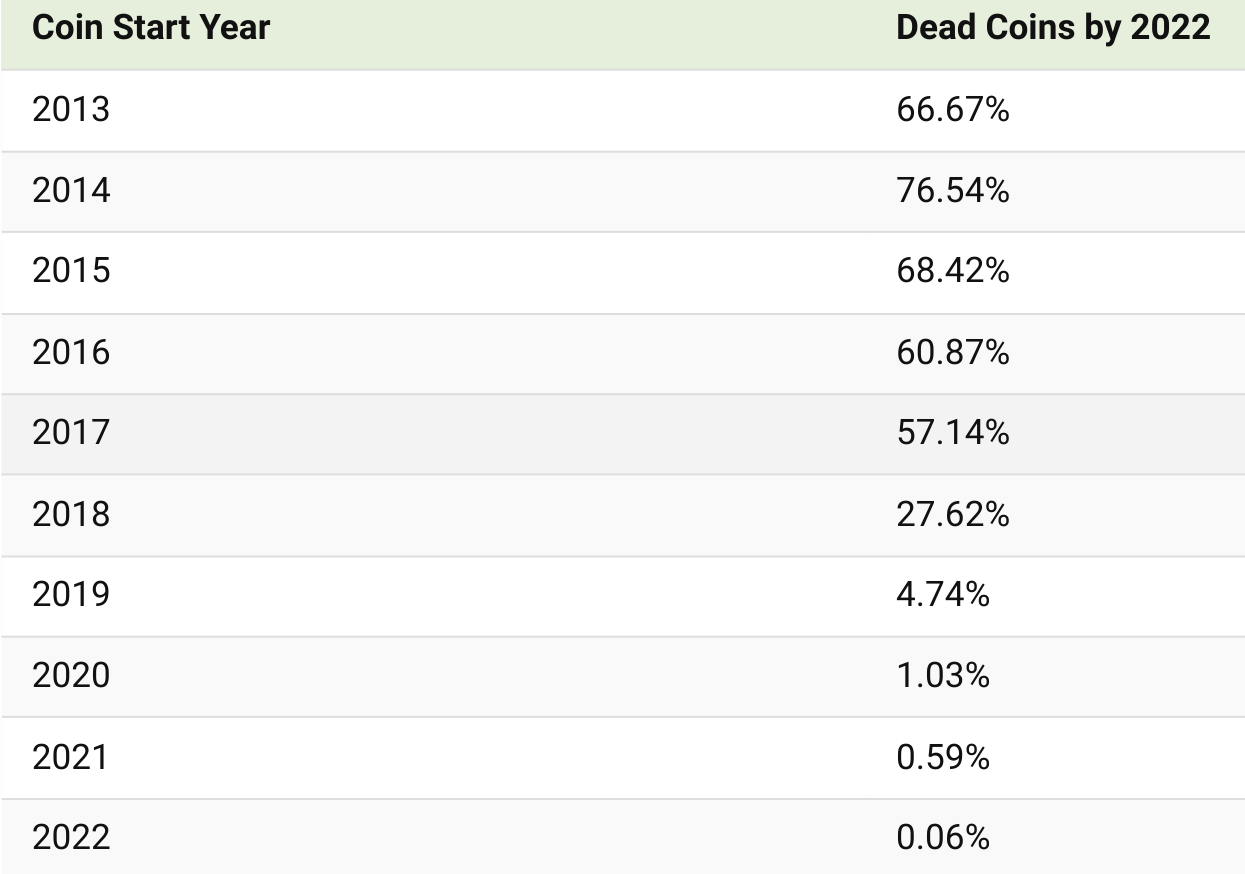Initial coin offerings (ICOs) have emerged as a novel way for early-stage ventures to fund their projects. Since garnering widespread adoption in 2017, ICOs have raised over $50 billion for crypto startups across the world.
Getting a clear picture of the global impact of ICOs can be challenging as information is scattered across a variety of reports and sources. That’s why we’ve done all the legwork to bring you over 70 ICO statistics you need to know, including success rates, earnings data, and more.
ICO Statistics Highlights
- ICOs have raised over $50 billion since their inception.
- Over 80% of ICOs during the 2018 boom were scams.
- ICOs have a survival rate of 10%.
- The largest ICO – EOS – raised $4.2 billion in 2018.
- The biggest ICO scam, Bitconnect defrauded investors of $2.6 billion.
Key Statistics About ICOs
The concept of an ICO was first introduced by J.R. Willet in 2013.
In an initial coin offering (ICO), a company creates a new digital asset, called a token, and puts it up for sale to investors using blockchain technology. In 2013, Willet used this method with MasterCoin, later rebranded as OMNI, and raised $500,000 worth of Bitcoin. The funds were used for development, payment of bounties, and other important tasks.
Following the success of OMNI, a wave of ICOs emerged. These were enabled by Ethereum, which managed to secure over $15 million of its own in investment in August 2014.
In 2015, Ethereum’s introduction of a standard for implementing tokens (ERC20) further streamlined the ICO process. From just 9 ICOs in 2015 and 74 in 2016, the market surged to over 1,000 ICOs in 2018.
Between 2017 and 2020, ICOs delivered over 3.5 times more capital for Blockchain-based startups than traditional venture capital (VC) rounds.
ICOs are digital tokens issued by early-stage ventures in exchange for crypto assets or fiat currencies. They represent a new way for early-stage ventures to raise capital/funding.
Compared to other traditional ways of raising such as venture capital and angel finance, ICOs offer several advantages:
- ICOs are completely decentralized as they are powered by Blockchain technology.
- Entrepreneurs don’t need to give up significant equity to raise capital.
- Funds can be raised relatively quickly from a global pool of investors.
- Anyone can invest in ICOs as there aren’t any securities laws limiting funding to wealthy accredited investors.
- ICOs are open to all entrepreneurs and not just those with connections to early-stage investors.
- Unlike IPOs, an established business model isn’t a requirement to receive investment.
ICOs are different from other traditional financing methods due to the following:
- Tokens: Units of value issued in the form of currency, utility, or security tokens.
- Whitepapers: Published information on the issuer, project, protocols, token supply, pricing, and distribution.
- Online marketing: The primary communication and distribution channel for ICOs.
The largest ICOs tend to use utility tokens with no explicit rights to the ownership or the future cash flows of a firm.
Currency tokens include cryptocurrency, that can be exchanged and stored. Security tokens are traditional securities backed by a blockchain infrastructure. Utility tokens (the most common type of token), grant investors rights to access a product or service.
According to Crypto Vantage, ICOs have raised over $50 billion for startups as of December 2022.
In a 2020 study of over 5,036 ICOs between 2016 and 2019, ICOs worldwide raised well over $13 billion. Statista pegged this figure slightly higher, reporting a figure of over $14.8 billion for the same period.
In 2017 alone, an estimated $4.9 billion was raised through ICOs according to Cruchbase and Wall Street Journal. By 2018, this figure jumped to $33.4 billion, more than the total amount raised by venture capital investment on internet projects.
Breaking down the figures, $90 million was raised from 29 ICOs in 2016. This surged to $7.5 billion from over 1,253 ICOs in 2018.
However, in 2019, this dropped to just $370 million raised from 109 ICOs. By 2022, this decreased to $117 million raised from 217 ICOs. According to researchers, the sharp decline in ICOs was brought on by challenges such as project failures, scams, and a lack of regulation.
Another potential explanation for the decrease in the number and volume of ICOs after 2019 is the development of new crowdfunding models. These new models seek to address some of the key challenges of ICOs.
Examples include:
- Security Token Offering (STO): A financial instrument offered through DLT
- Initial Exchange Offering (IEO): A crypto token or utility offered and managed through an exchange launchpad.
- Initial DEX Offerings (IDO): A crypto token or utility offered and managed through a decentralized exchange.
- Token Generation Event (TGE): A blockchain-based project or platform that raises capital through the sale of its native tokens to investors and supporters
| Year | ICOs Published | Funds Raised |
| 2016 | 29 | $90 million |
| 2017 | 875 | $6 billion |
| 2018 | 1,253 | $7.5 billion |
| 2019 | 109 | $370 million |
| 2020 | 14 | $55.6 million |
| 2021 | 320 | $378 million |
| 2022 | 217 | $117 million |
A 2020 report analyzed 981 ICOs that took place in 2019 and found the following:
- The UK, Singapore, and Taiwan were central hubs for ICOs in 2019.
- Overall, the total number of ICOs fell by 60% from 2018.
- 88% of ICOs were based on the Ethereum blockchain.
- A majority of the tokens that were issued in 2019 ICOs were not traded on secondary markets anymore by July 2020.
- Of the ICOs for which data was available (24%), $3 billion was raised, with the largest ICO being BITFINEX (Taiwan) which raised a total of $1 billion.
- 43% of ICO issuers had an actual product on the market, while close to a third did not.
2023 data on Foundico, an aggregation platform for over 3,000 ICOs and pre-ICOs revealed that:
- A majority (36%) of all ICOs on the platform are finance projects, followed by trading (13%) and payments (10%).
- The most common project platform is Ethereum, accounting for over 72% of ICOs.
- The US takes the lead in terms of the highest number of projects, with 451 in total. This is followed by the UK and Singapore with 383 and 304 projects respectively.
- The most funds are raised in the US, followed by Singapore and the UK.
- Since January 2023, over 120 ICOs have been published.
Data from ICO Drops shows that there are currently 13 active ICOs on its platform and that there have been over 100 ICOs since March 2023. Some of the top-performing ICOs for the period include:
- Arbitrum, which raised $123.7 million.
- World Coin, which raised $240 million.
- SUI, which raised $52 million.
- Neon, which raised $ 45 million.
- Republic Note, which raised $49 million.
Data compiled by Cryptorank on a total of 4,554 public token sales between 2014 and 2023 shows that ICOs account for 18.4% of all public token sales.
At 66.1%, IDOs have emerged as one of the most popular fundraising methods for crypto startups. In third place are IEOs which account for 15.5% of all token sales.
The country with the highest number of recorded ICOs is the US. This is followed by Singapore and the UK. China, Nepal, Bangladesh, Macedonia, Bolivia, and Ecuador are examples of countries that have banned ICOs.
Across the world, ICOs face growing scrutiny. Policymakers have yet to formulate a cohesive strategy to address key challenges in the ICO market. Some pressing concerns identified include the high risk of money laundering and the fact that ICOs may be used to finance terrorism.
The average ICO campaign lasts 40 days and successful projects end with the listing of the tokens.
Good ICO campaigns tend to last a few days, while bad campaigns last substantially longer. As mentioned above, listing on a centralized crypto exchange (CEX) or decentralized crypto exchange (DEX) is the mark of a successful campaign.
There is no conclusive data on first-time token listings in DEX vs. CEX. However, DEXs represented close to 10% of the volumes of trade of CEX as of 2021.
ICO Earnings Data
While ICOs tend to have higher average initial returns of around 110%, they are also more likely to yield negative returns. Research suggests that it is riskier to invest in ICOs, but the profit potential is greater. In addition, information asymmetry is more severe in the cryptocurrency market, leading to more uncertainty in ICO valuation and earnings.
A study of the performance of ICOs revealed total or major losses of up to 90% over six months. In comparison, the figure was only 23% for IPOs. ICOs carry significant risks for investors. This is mainly because:
- ICOs are largely unregulated.
- Issuers can take advantage of regulatory loopholes.
- The market is plagued by scams and other fraudulent activity.
- Even promising projects may fail to yield returns.
Unlike VC or angel investors, ICO investors don’t receive any protection against losses, nor do they get a say in how things are run.
Only 4% of ICOs present clear goals that must be reached before funds are released, and only 4% ensure an unbiased third party oversees the money collected by the company. As a result, most investors don’t benefit from ongoing profits. There’s also a very high risk they won’t get their money back.
Nevertheless, ICOs can yield moderate to high returns for investors. Using the weighted return value of the top 10 digital currencies in 2021 as a benchmark, average token returns were:
- 112% for the first day
- 44.1% over 90 days
- 81.3% over 180 days
- 71.4% over one year
A 2020 study found that the average ICO had 4,700 contributors, with the median investor in the sample investing around $1,200.
Additionally, nine-month returns were found to be positive on average, mainly driven by the appreciation of Ethereum.
A 2018 Boston College study analyzed data from over 2,390 completed ICOs and found that the average investor earned returns of 179% between ICO pricing and the first day’s opening market price.
During ICOs, issuers tend to sell their tokens at significantly discounted prices. This results in returns that are well over 100% between the average holding period of 16 days from the ICO end date to the listing date.
Even after trading begins, tokens continue to appreciate, generating abnormally high average returns of up to 82% on the first day of trading and average returns of 48% in the first 30 days.
A 2020 study revealed there was a 12% likelihood of ICO investors’ tokens trading above their issue price after 6 months. This is down from 17% in 2019. The same report found that nearly 90% of tokens were trading below their ICO price. In addition, 65% of tokens had lost almost all of their value by July 2020.
| Year | Top 10 ICOs | Amount Raised | Project |
| 2018 | EOS | $4.1 billion | Smart Contracts |
| 2018 | Telegram Open Network | $1.7 billion | Encrypted Messaging & Blockchain Ecosystem |
| 2019 | Bitfinex | $1.0 billion | Digital Asset Trading Platform |
| 2018 | Dragon Coin | $407 million | Decentralized Currency for Casinos |
| 2018 | Huobi Token | $300 million | Cryptocurrency Exchange |
| 2017 | Hyundai DAC | $258 million | IoT Contract & Payment Platform |
| 2017 | Filecoin | $257 million | Decentralized Cloud Storage |
| 2017 | Tezos | $232 million | Self-Amending Distributed Ledger |
| 2017 | Sirin Labs | $157 million | Open-Source Blockchain Smartphone |
| 2017 | Bancor | $153 million | Prediction Markets |
Examples of ICOs that earned investors a high return on investment (ROI) include:
- Nxt ICO was launched in 2013 at $0.0000168 and hit $1.94 in 2017 for an ROI of 11,547,519%.
- IOTA investors had a 522,900% ROI.
- Neo investors had an ROI of 378,453% in 2018.
- Investors who bought Ethereum at its starting price of $0.31 and sold their tokens at its peak of $4,362 made an ROI of over 1,400,000%.
- After its $5.5 million ICO, DigixDAO’s starting price was $3.20. It reached a peak of $510 in 2021, giving investors an ROI of over 12,000%.
- Investors who bought Stratis at $0.007 saw a 300,000% ROI in 2018.
- Cardano saw its token rise from $0.0024 to a high of $2.46 in May 2021, delivering gains of over 1020x or 54,000%.
ICO Success Rates
A comprehensive study of 3,392 completed ICOs between January 2016 and December 2018 found that the success rate for ICOs was nearly 90% in the first half of 2017.
However, this dropped sharply to just under 50% in the second half of the year. By Q4, 2018, the success rate was around 30%. The authors note plummeting digital currency prices and the threat of regulation as major contributors to the falling success rates.
Out of over 4,000 planned and executed ICOs in 2018, the survival rate of startups 3 months after an ICO was only around 44.2%.
Additionally:
- 56% of crypto startups that raised money through ICOs failed within four months.
- 83% of ICOs that didn’t report capital and didn’t list on an exchange were inactive after 120 days. For those that raised capital, this dropped to 52%.
- For ICOs that were listed on an exchange, only 16% were inactive by the fifth month.
Insights by Enterprise Risk Mag revealed that a whopping 90% of ICOs failed in 2019. This implies that ICOs had a success rate of around 10%, a significant drop from 2017 and 2018 levels.
Successful ICO Examples
In 2018, EOS generated $4.2 billion worth of investment through its ICO, making it one of the most successful ICOs.
EOS was worth $14.64 when it launched and at its peak, traded for $22.89. As of August 23, 2023, EOS is worth $0.59. With a market cap of $649 million, it is ranked 58th in the world.
In July 2014, Ethereum’s ICO was successful and raised $18.4 million.
Ethereum is the world’s second-largest cryptocurrency with a market cap of over $200 billion in August 2023. From an all-time high of $4,891 in November 2021, Ethereum is now trading at around $1,678.
Improving on certain aspects of Ethereum, Cardano had a successful ICO and raised $62.2 million in January 2017.
With a market cap of over $9 billion, Cardano is the eighth-largest cryptocurrency in the world. At its all-time high, Cardano traded at $3.09. As of August 23, 2023, Cardano is worth $0.27.
ICO Failures
According to data by Visual Capitalist, there were 2,383 defunct cryptocurrency coins between 2013 and 2022.
10% failed to launch after an ICO. Abandoned coins with no trading volume accounted for 1,584 or 66.5% of crypto failures while 22% were scam coins. Additionally, of the coins launched in 2017, more than 50% were defunct by the end of 2022.
The highest number of ICO failures occurred between 2017 and 2019. After 2019, coin failures fell below 5%.
- There were 46 failures in 2017.
- There were 112 failures in 2018.
- There were 51 failures in 2019.
Failed ICO Examples
Although Tezos raised $232 million through its ICO in July 2017, it wasn’t a complete success.
After the ICO, there were several delays in distributing the tokens sold. This led to a class action lawsuit. Consequently, Tezos reached a $25 million settlement with all parties in 2020.
In 2018 Telegram raised $1.7 billion through 2 ICOs for its Telegram Open Network (TON) March 2018.
Unfortunately, the SEC stopped the distribution of Telegram’s tokens and prohibited its launch in the US. Telegram was also ordered to pay $1.2 billion in refunds to investors.
In March 2018, Dragon Coins raised $320 million. A series of controversies resulted in the token’s price plummeting shortly after being made available for public trading.
Dragon Coin reached an all-time high of $2.40 on March 21, 2018. By 2021, its market capitalization had fallen below $1 million. Its lowest price was recorded on Aug 5, 2022, when it traded at $ 0.00004. As of 23 August 2023, its market cap stands at only $27,684.
What Makes a Successful ICO?
By industry convention, an ICO is considered a success if it raises more than the soft cap or minimum goal amount. If an ICO doesn’t reach its soft cap, funds are usually returned to investors. In rare cases, a team may decide to forge ahead.
According to PwC, what makes a successful ICO includes:
- A capable team: Successful ICOs are led by qualified, capable, and well-rounded teams.
- A viable use case: Use cases solve problems and have real applications.
- Business model: Successful ICOs have sustainable and scalable business models.
- Institutional mindset: This refers to a strong motivation to build a long-term institutional-grade business.
When comparing the differences between failed and successful ICOs:
- Successful ICOs receive more positive ratings from online experts.
- The average minimum funding goal or soft cap for successful ICOs is $5 million while the average hard cap or maximum funding goal for a successful ICO is $57 million.
- 59% of successful ICOs include a presale before the main token sale.
- Bonuses of 20% or more are more prevalent in failed ICOs.
- 40% of successful token sales ask for customer identification.
Cryptocurrency Prices
A 2022 study analyzed 428 ICO projects to determine ICO success factors and found that the prices of cryptocurrencies, namely, Bitcoin and Ethereum, were inversely related to project success.
A lower Bitcoin price is related to more successful projects while Ethereum has more successful projects when its price is higher. Another study found that ICOs that accept multiple digital currencies are also more likely to succeed.
Funds Raised
Successful ICOs achieve 55.4% of their maximum funding goal or hard cap and have around 2,480 supporters. on average. They also raise an average of $14.7 million over an average of 54 days compared to 68 days for failed ICOs.
A strong social network presence influences project success.
- Having an active Twitter account during the ICO campaign is associated with successful projects (32%), in contrast to not having an active Twitter campaign (15%).
- Having more followers was linked to successful projects (32%), in contrast to having smaller networks (16%).
- Having an active GitHub account was linked to greater success (28%) than not having one (19%).
- More projects were considered successful when they had an active website (30%) than when they didn’t (17%).
Whitepaper Characteristics
Whitepaper availability and length positively influence ICO success (29%). Projects that disclose more information are more likely to succeed.
Additionally, token sales featuring multi-language websites or whitepapers tend to be more successful. Overall, ICOs missing whitepapers have significantly lower fundraising success rates, raise less funds, and are less likely to be listed.
Team Variables
The team variables necessary for a project’s success are the number of team members and LinkedIn networks. Larger teams have more successful projects (29%) compared to 18% for smaller teams.
Similarly, larger LinkedIn networks are associated with higher percentages of successful projects (29%) compared to 19% for smaller ones.
ICO Scams and Controversies
Fraud remains one of the greatest challenges and threats to the ICO market – a fact that was recognized by regulators and market agents during the 2017-2018 boom.
In 2017, Securities and Exchanges Commission (SEC) chairman Jay Clayton expressed concern over the levels of fraud being committed in the ICO market and stressed that regulatory action was necessary to protect investors.
Clayton said, “A number of concerns have been raised regarding the cryptocurrency and ICO markets, including that as they are currently operating, there is substantially less investor protection than in our traditional securities markets, with correspondingly greater opportunities for fraud and manipulation.”
In a study of over 5,036 ICOs between August 2014 and December 2019, only 20% or 1,014 had available funding data.
Of these ICOs, 576 or 57% turned out to be scams and led to losses of over $10.12 billion. The largest scam recorded was the ‘Petro-scam’, which cost investors a total of $735 million.
The same study identified that phishing and fraud scams were the most common types of tactics used on investors. These scams typically involve spam emails, suspicious links or popups, errors on withdrawals, and balances disappearing from wallets.
Additionally, if an ICO project turned out to be a phishing or fraud scam, estimated losses amounted to about $54.1 million, which is three times the general average of $17.6 million.
Other top ICO scams identified by the study were:
- Dead/fake ICOs: Scammers fool investors into funding dead or fake projects.
- Bounty scams: ICOs fail to pay promoters who were promised payment for PR and advertising.
- Exit scams: ICOs that simply disappear, leaving investors to deal with major losses.
- Airdrop scams: Scammers use the promise of free tokens to steal private keys from investors.
- Exchange scams: Scammers deceive investors by launching on a fraudulent exchange.
- Pump and dump: Once scammers create hype and sell their ICO, the price drops rapidly and dramatically.
- URL scams: Investors are tricked into investing by websites imitating existing projects.
- Porn scams: An ICO pretends to offer premium access to its porn site, preying on victims’ reluctance to report being scammed.
- Market manipulation or pre-mines: Tokens are shared among developers or promoters after the final token sale and not burned, leading to higher token circulation and a lower token price.
| ICO Scam | Amount Stolen |
| Bitconnect | $2.6 billion |
| Pincoin | $660 million |
| ACChain | $60 million |
| Savedroid | $50 million |
| Plexcoin | $15 million |
A 2018 report by Satis Research Group analyzed over 1,500 ICOs in 2018 and found that 78% of projects were scams valued at approximately $1.3 billion.
Even though a majority of projects were scams, over 70% of ICO funding went to higher-quality projects. Additionally, 54% of ICO fundraising went to projects that were classified as successful at the time of writing.
Meanwhile, a significant share of the $1.3 billion went to three projects that were later subject to extensive regulatory action. Namely:
- Pincoin: Raised $660 million, disappeared with investor funds, and is under investigation by Vietnamese authorities.
- Arisebank: Raised $600 million and was brought to a halt in January 2018 by the SEC.
- Savedroid: Raised $50 million and was under preliminary investigation by the public prosecutor in Frankfurt in April 2018.
Bitconnect is by far the biggest ICO scam to date. Bitconnect was an open-source cryptocurrency that promised investors returns of up to 40%. However, it turned out to be a Ponzi scheme that cost investors over $2.6 billion.
ACChain, a promising ICO created in Shenzhen, China, makes the top 3 of the biggest ICO scams.
ACChain raised over $60 million during its ICO, however when a picture of its headquarters was leaked, investors learned it was nothing more than an empty room. The company subsequently vanished, leaving investors to deal with major losses.
The Plexcoin ICO scam promised investors a return of 1,354%. Plexcoin managed to raise $15 million before it was shut down by the SEC and ordered to pay back investors.
In July 2017, CoinDash/Blox was hacked, resulting in losses of $7 million in just half an hour. Hackers hijacked CoinDash’s ICO, changed payment instructions, and rerouted all funds to their own accounts.
FAQs
What was the largest ICO?
What is the success rate of an ICO?
What is an ICO?
How to do an ICO?
Sources
- Science Direct: Optimal Initial Coin Offering Under Speculative Token Trading
- Deloitte: ICOs – The New IPOs? Report
- Appinventiv
- Science Direct: Read Me If You Can! An Analysis Of Ico White Papers
- Crypto Vantage
- Research Gate: How Much Are We Willing To Lose in Cyberspace?
- Statista
- Crunchbase
- Science Direct: Challenges Of The Market For Initial Coin Offerings
- SSRN: ICO Market Report 2019/2020
- Foundico
- Ico Drops
- Cryptorank
- Motley Fool
- Science Direct: Initial Coin Offerings And Their Initial Returns
- Springer Link: ICO Investors
- SSRN: Digital Tulips? Returns to Investors in Initial Coin Offerings
- ICO Listing Online
- Enterprise Risk Mag
- Bitcoin Market Journal
- Visual Capitalist
- Bloomberg
- PwC
- Springer Link: Initial Coin Offerings: Why Do They Succeed?
- IOSCO: Statement on Cryptocurrencies and ICOs
- Bloomberg
- Crypto Head

